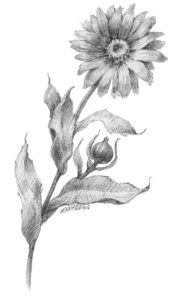August, A Garden of Simples
Let thy kitchen be thy apothecary, and let foods be thy medicine.
—Hippocrates
By Leslie Watkins
How nice to pinch a sprig of peppermint to add to your drink, or to collect basil and garlic from your garden for an impromptu pesto. Chives, parsley, and dill are wonderful plants to have close at hand to add that extra fresh taste to your favorite recipes. Useful herbs may be grown in pots or beds just outside your kitchen door for convenience, and many of these herbs are great pollinator plants attracting bees, butterflies and hummingbirds. Many useful herbs are in the mint family, including lemon balm, rosemary, bee balm, oregano, sage, lavender and thyme. All are delicious and some are considered to have medicinal benefits as well.

Calendula, by Leslie Watkins © 2018
North and South American Indian, Ayurvedic, Chinese, Roman, Mayan, Aztec, Middle Eastern, Egyptian and other civilizations all used herbs to treat illness, restore healthful balance, flavor their foods, cleanse their homes and care for their bodies. We are descended from people who perfumed their hair and skin with herbal oils, drank powerful herbal teas and prepared food seasoned with herbs that have medicinal properties. The emperor Charlemagne proclaimed, “An herb is the friend of physicians and the praise of cooks.” Remains of Neanderthals and Egyptian mummies include seeds of the herbs they valued. The ancient cave painters of Lascaux depicted herbal aromatic medicines. Even primates know and use plants that have the power to heal.
The World Health Organization estimates that much of the world still relies heavily upon plants as the primary source of their healthy remedies. Herbal medicine is the oldest and most widely practiced system of healing. Its effectiveness has been proven by centuries of empirical use and is ecologically sound. Herbalists’ work is connecting people with plants that can help them find physical, emotional and spiritual balance. In America, however, it has been illegal to practice traditional herbal medicine since 1840. Contemporary laws prohibit herbalists from diagnosing and treating disease, or claiming herbs to be medicine.
Herbs are very easy to to grow and readily available. Traditional herbal preparations are surprisingly simple and fun to make. They include tinctures, oils, teas, salves, balms and poultices. Here are five useful and attractive herbs to grow in your garden along with their indications.
- Pot marigold (Calendula officinalis) is antiseptic, antimicrobial and anti-fungal. It’s soothing to skin irritations. Prepare the dried flowers with virgin olive oil to use in salves and lip balms. The edible flowers may be added to salads, soups and tea blends.
- German chamomile (Chamomilla recutita) is antiseptic and anti-inflammatory. The flowers are dried and brewed as a relaxing tea, good for digestion and muscle cramps.
- Lemon balm (Melissa officinalis) is antiviral and antidepressant. It is used for hyperactivity and calming in the bath and in tea blends. It’s delicious in fruit salads and makes a fragrant and soothing massage oil.
- Bee balm (Monarda didyma) leaves make a tasty tea that can be helpful for headaches, colds, sore throats and as an aid to digestion. It can be used in recipes similarly to oregano, and its fresh flowers make an aromatic garnish.
- Yarrow (Achillea millefolium) is antiseptic, anti-inflammatory, hemostatic and antiallergenic. Poultices may be applied to wounds, cuts, abrasions and burns. Leaves can be used for nose bleeds. Inhaling steam infused with yarrow flowers may relieve hay fever symptoms and open contracted airways.
Always be certain of plant identification before ingesting any collected material. Some individuals may have adverse reactions to various plant species and that is not always possible to predict. This publication and the author do not accept responsibility for any personal experimentation with ingesting herbs or using herbal remedies. This information is for general and educational purposes only. Please seek professional help for any serious medical conditions.
Some Useful Herbs
- Burdock
- Comfrey
- Dandelion
- Echinacea
- Elderflower
- Feverfew
- Lavender
- Mullein
- Rosemary
- Stinging nettle
